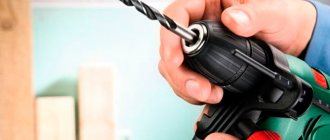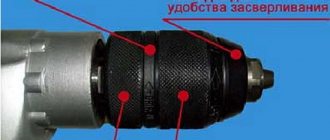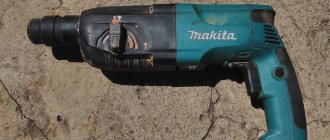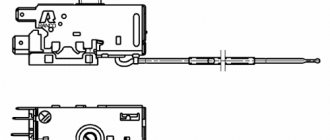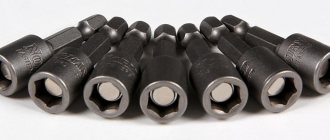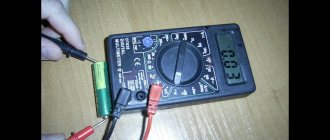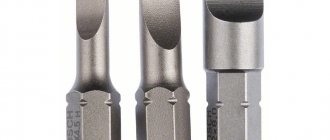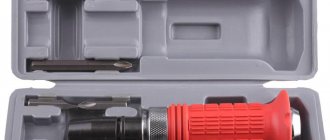Drill chuck: how to remove, change, disassemble - video, photo
Among home craftsmen, two types of drill chucks are most common - main (gear-toothed) and quick-clamping (BZP). We will try to analyze the operating features of these particular cartridges below and comprehensively cover what our client can do with the main aspects and difficulties of working with it.
More common for household drills and screwdrivers are ring-gear and quick-release chucks
Classification of cartridges
The following types of cartridges exist:
- quick-release or self-clamping device;
- collet-type sds devices;
- cam
On a drill with a quick-release chuck, you can change a drill or other attachment quite quickly, without the need to use any additional devices. The cartridges of the first option are divided into single- and double-coupling devices.
Single-coupling devices have a shaft locking system that is activated during tool replacement. They have a significant negative point - very low strength of the fixation elements; the external parts of the cartridge are made of plastic, which greatly increases their damage and breakdown of the entire device.
Repair of this type of cartridge is not provided - only replacement.
Manufacturers use cam-type products on impact models and hammer drills because their design is stronger - they mainly use key-type chucks to securely fasten the drill.
The collet-type chuck was created back in the 70s of the last century; its design differs in that there are two grooves in the tail part, and the drill must be deepened by screwing movements by 40 mm. There are 4 grooves: 2 fixing, 2 for guiding the wedges, the cutting tool is fixed with locking balls.
With a classic gear device, the tightening is adjusted using a chuck key that comes with the drill. To properly unscrew the cartridge, you must follow the recommendations of an experienced technician; to do this, watch this video:
Mounting methods
The chuck is attached to the shaft of an electric or manual drill in two ways - a cone connection and a thread, so there are a minimum of varieties here. In practice, there are devices with metric or inch threads, and on the body of the product, even the smallest one, there is always a marking.
For example, a designation of this type 1.5-15M13x1.2 is deciphered as follows:
- 1.5-15 is the diameter of the tail part of the cutting tool in millimeters;
- M13 - metric thread with a diameter of 13 mm;
- 1.2 - thread pitch.
When using a thread in inches - UNF and the diameter is indicated: 1/2”. This type of connection is considered international and is used in all instruments from foreign manufacturers. For special reliability, a stopper is placed on the shaft, in the form of a screw on the left thread - this must be taken into account when you are confused about how to disassemble the chuck of an imported drill. It only needs to be unscrewed clockwise.
The second method uses a Morse cone, which today is more often called an instrumental cone. The shaft has a conical part at the end onto which the device is mounted, and a small force must be applied for a tight connection. The marking is as follows: B10, where the letter indicates the use of a cone, and the number indicates the diameter of the tail of the cutting tool. This type of fastening is common with screwdrivers.
Some drills are equipped with an adapter for the clamping mechanism, which allows drilling with maximum accuracy.
Types of fastenings for screwdriver attachments
Mounting options also affect how screwdrivers are used. If there is a conflict between the mechanisms, a problem may arise in correctly screwing the screws into a hard surface. Therefore, it is recommended to purchase cartridges only with the type of mount that is provided on the tool itself.
Type "Morse Cone"
This fastening option has been used on devices with a rotating mechanism for decades. It can rightfully be considered one of the popular ones. If you look closely at the design, its shaft resembles a cone, exactly the same as that of the cartridge. Thanks to the identical base, it is easy to connect the two parts together by hand. All pneumatic models of screwdrivers are equipped with this mechanism.
Threaded fastening
This switching option is the presence of larger and smaller threads on the shaft and chuck that fit together. The base of the cylinder is screwed onto the shaft.
Fixing screw
The screw has a Phillips head, which can be seen by moving the jaws apart. The screw fastenings have a cross head and left-hand threading. Such a screw can be easily unscrewed using a regular flat-head screwdriver, provided that its size matches the diameter of the inlet hole.
For your information!
Do not try to halve the screwdriver to unscrew the screw (if it has such a fastening method) immediately after work. At this moment, the tool is very hot, so it may jam. And a screwdriver will only “lick” the edge.
How to determine the mounting method on your instrument
Studying the working mechanism of the cartridge and the head of the electrical device itself will help you quickly understand how the fastening of the moving structure is organized. Look carefully at the markings that are indicated on the body of the device or on the removable head itself. Usually the following symbols are written on it: 1-6 B10, where:
- 1-6 — shank size in diameter;
- B10 - cone size (you can find it in any reference book);
As for the threaded connection, its marking usually looks like this: 1.0−11 M12×125. Where M12×125 are the parameters of the metric thread, and 1.0−11 are the maximum dimensions of the tool that can be fixed in the chuck. Please note that if you purchased a foreign-made device, then all numbers should be converted into inches, while for domestic devices everything is measured in mm.
Cartridge mechanism problems
In modern drill models, such as Interskol or Makita, the drill or other attachments are secured by a chuck with a cam mechanism: 3 or 4 cams securely hold the cutting tool; they can only move along the axis of the drill shaft. The keyless chuck is adjusted manually; more complex designs used in modern drills are adjusted using a key.
During operation, a beating of the clamped bit may occur; the cause is wear of the cams during long-term operation. The tool is repaired as follows: you need to remove the device from the shaft; the same actions are necessary when the drill jams, because it can only be removed after completely disassembling the cartridge part of the product.
The following malfunction also occurs: the chuck rotates relative to the tool shaft. The reason for this behavior is damage to the threaded part of the device mount, or subsidence has occurred at the landing cone. The way out of this situation is to replace the cartridge with a working analogue.
Analysis of a drill with a Morse taper
There are drill models that use a chuck not with jaws (jaw chuck), but with a threaded connection (or Morse taper). You can choose an adapter for it, or continue to work with this cone - it all depends on preference. In order to repair a drill or screwdriver, it is important to decide which cartridge. They have a similar appearance, so you need to look at the markings that are stamped on the surface of the part. If the cartridge is marked with the letter B, it is a device with a Morse taper. In this case, you can remove the cartridge using a drift and a plumber's hammer.
Tool for work
Replacing a drill chuck is easy if you know the design of this unit and the methods for attaching it. To carry out repairs you will need a simple set of tools:
- bench vice, you can use not the standard one, but a smaller version for home needs;
- steel hammer;
- carpenter's mallet;
- pliers or pliers;
- medium size pipe wrench;
- set of wrenches;
- calipers;
- screwdriver;
- file;
- sandpaper for sanding.
The list shows the minimum set; there are situations when other plumbing equipment may be required.
Dismantling the cartridge
Depending on how the chuck mechanism is mounted, disassembly methods will vary.
Threaded connection
This structure must be disassembled in this order.
- Carefully unscrew the locking screw.
- We unscrew the cartridge counterclockwise, if the thread is tightened properly, we clamp the tool shaft in a vice. A gas wrench is used to unscrew it. Then we remove the device and inspect it for integrity and serviceability.
- If the drill is jammed in the jaws, then we apply not strong, but precise blows with a hammer using a drift on the cams from above.
Installation is carried out in reverse order. When screwing in a new device, the shaft must be secured against rotation with your free hand. Lastly, tighten the locking device. Video to help home crafters:
Cone connection
Removing the cartridge from the tapered part of the shaft is quite easy. The drill kit should have a special device for these purposes, but many experienced craftsmen use this method: they turn the tool over with the drill down, secure it, and evenly hit the back side with a hammer to knock the device out of the shaft.
After dismantling, you need to sand the conical surfaces using an emery cloth; if there are surface burrs, remove them with a file. The new cartridge is installed in place even easier - by hitting it with a mallet on top, it fits tightly into the joint.
Users need to remember that removing a drill or other attachment when it is jammed in a chuck requires certain skills and ability to handle plumbing tools, but in any case the device must be dismantled. If the chuck on the drill fails, it must be replaced.
An electric drill is an indispensable tool attribute of both the home craftsman and the professional. Without this tool, it is difficult to carry out any work related to the production of something, as well as installation, dismantling, and so on.
Read also: Dimensions of roofing screws for metal table
Breakdown of a drill, even of a famous brand, eventually happens. And one of the most common failures of this power tool is the failure of the chuck: both the key and the self-clamping one.
How to open a drill chuck?
The purpose of the drill chuck is to securely fasten the drill or other attachments (construction mixer, grinding wheel, etc.). Fixation is carried out by three mechanical “fingers”, which are brought together and apart using a threaded mechanism.
There are two main types of cartridge:
- Keyless variety. To open such a structure, it is enough to wrap your fingers around the body and, turning on the reverse rotation, briefly press the trigger of the tool. The drill itself will rotate the shaft, spreading the “fingers” that fix the drill. Such a chuck is easier to use, but the reliability of fixing the tool will be somewhat lower.
- A type equipped with a key. The key is a T-shaped device, at one end of which there is a bevel gear. The other two ends serve as a handle for rotation. To unscrew or tighten the cartridge, the key is inserted into the hole in the housing and rotated while holding the housing with the other hand.
Typically, a key is included with the power tool. It either lies in the box or is attached to the power cord with a special fastener.
Removing the threaded cartridge
To remove it you will need a screwdriver.
It turns out a screw screwed into the tool spindle and installed inside the product. After which it twists off the spindle. As mentioned above, the internal screw has a left-hand thread, therefore it rotates clockwise. True, the cartridge is unscrewed counterclockwise, since, on the contrary, it has a right-hand thread. If the screw does not want to come out, tap it with a hammer using a screwdriver . There should be no difficulties with the cartridge; it unscrews easily. Although if difficulties arise, you can use open-end wrenches and gas wrenches. Attach the spindle to the drill first, and grip the chuck last.
In addition, when the chuck has functioning clamping jaws, a thicker hexagon can be installed to turn it out. You also need to secure the spindle using an open-end wrench. Most modern battery-powered drills do not require any additional attachments to mount the drill. However, changing the cartridge for them is very difficult.
When this does not help to remove it, the tool body is disassembled . Thus, it is possible to reach the spindle, since it is hidden when assembled. Then everything is put back together, but without using keys.
What to do if the internal screw is damaged during the replacement process? In this situation, it is better to purchase an adapter for a chuck for a cam-type hammer drill, since it comes with a screw.
How to replace a cone specimen?
There should not be any difficulties when removing the element mounted on the shaft cone. You can use a special tool that is used to replace bearings.
But the easiest way is to place the tool vertically, with the drill pointing down. Then you need to gently tap the entire surface with a hammer until the cartridge is disengaged. If necessary, it is polished. The new part is inserted with light blows from above.
Reasons for replacing the drill chuck
Sooner or later, any part, assembly or any mechanism becomes unusable.
In modern drills, such as Makita, Interskol, Bosch, and so on, the drill and other cutting tools, as well as all kinds of attachments, are fastened using a cam-type device . The cam mechanism consists of 3 or 4 cams, through which the tool is held in the drill chuck. If the device is quick-clamping, then the mechanism is tightened by hand, and if it is a key device, it is tightened with a special key.
There are also collet devices, but they are more applicable in metalworking production. They hold all kinds of tools needed for work.
Reasons for replacement:
- Runout during rotation. This indicates wear on the cams or front shaft bearings.
- Rotation on the shaft. The reason is damage to the thread, if the chuck is threaded, or wear of the tool cone.
In both cases it needs to be replaced.
Beating is a harmful and unsafe phenomenon; it can be characterized as follows:
- The cutting tool does not hold well in the drill, or any equipment.
- Drills jam (in the case when the cone is worn out).
- The holes are of irregular shape.
- The drill shanks wear out.
The drill and screwdriver chuck is jammed, how to fix this situation
Typically, chuck jamming occurs due to improper operation of the device. For example, when you try to insert a drill of the wrong size into it, or you don’t give the mechanism a rest in a timely manner.
If such a situation has developed, the only way out is to disassemble the entire structure down to the smallest detail. Before you begin this painstaking process, you need to lubricate all movable parts with a special product (a solvent will also work). Most mechanics use WD spray for this purpose. It eliminates sticking between the contacts of connections and facilitates the movement of rubbing parts.
How to remove a chuck from an electric drill
The chuck can be attached to the spindle as follows:
- Cone mount. When a Morse taper (instrumental taper) is used. In this case, the shaft is made in the form of a cone, well polished and minimal effort is required to fit it. Example of marking: B10, where B is the symbol of the cone, and the number 10 is the diameter of the cutting tool shank. This type of fastening is most often found in screwdrivers.
- Threaded fastening. Threads can be metric or inch. If the M13 marking is stamped on the cartridge body, then the thread is metric, 13 mm. If it is inch - UNF indicating a diameter of ½ inch.
However, in order to protect the user 100%, the manufacturer of imported drills also fixes the chuck with a screw, which serves as a stopper and securely fastens it to the shaft.
The screw has a left-hand thread, and very often, when a drill is repaired by inexperienced people, the slot on the screw for the screwdriver is torn off out of ignorance, believing that it has a standard right-hand thread - so you need to unscrew it clockwise.
Knowing the design features of your own drill, removing the chuck does not seem to be a big problem.
In order to change this element, you need to prepare the following tools:
- Pipe wrench No. 2.
- Medium sized hammer. Approximately 400−500 gr.
- Spanners.
- Caliper No. 1, 2 or 3.
- A screwdriver with the required blade shape and section.
- Personal or velvet file.
- Sandpaper.
This list shows the minimum set of tools. It is very possible that during the work you will need something additional.
Threaded connection
Procedure for dismantling:
- Unscrew the locking screw counterclockwise.
- Unscrew the cartridge in the same direction. If there are grooves on the shaft, use a wrench to fix it.
- If the drill is jammed, then you should tap the cams from top to bottom with precise and light blows of the hammer.
- Installation of the device is carried out in the reverse order.
Having fixed the part of the equipment on which the cams are held with a pipe (gas) wrench No. 2, you need to rotate the shaft. The cartridge should unscrew easily after such “persistent” intervention.
Connection with a tool cone: dismantling step by step
Such dismantling is carried out using a hammer and a drift made of non-ferrous metal: brass, bronze, aluminum, copper. However, hammers of this type are still found.
Soft metal will not cause damage to the equipment in the form of nicks and deformations.
You need to do the following:
- Hold the drill with the handle up.
- Gently tap the back of the cartridge around the entire circumference with a hammer.
- After the device is dismantled, you need to clean the cone with fine sandpaper. Remove large nicks, if any, using a file.
- The new cartridge is inserted into its regular place and fixed with a blow from a wooden hammer (mallet).
For old drills made during the Soviet period, we can use another method. In them, on the shaft, between the tool body and the chuck, there is a fairly large gap, and there are flats on the shaft.
Locksmiths, as a rule, acted as follows:
- We inserted the key into these grooves.
- The clamping tool was dismantled by hitting the open-end wrench with a hammer.
The method, of course, is not the safest, given that the key can fly off along a trajectory unplanned by the locksmith and cause injury. There is also a type of drill where a slot is made in the body into which a wedge is inserted to knock out the chuck. Such drills may have two cones: one in the chuck and the other in the drill. These instruments are impressive in size and weight.
Taper drills are considered more accurate in critical drilling because the Morse taper is manufactured to a high degree of precision.
In addition, the conical chuck can be removed with a puller, since each such drill, which does not even have a threaded hole for a locking screw, has a through hole. And if you use a puller with a central pin and rest it against this hole, then by securing it to its counterpart, which has hooks in the form of powerful hooks, you can also remove the firmly attached cartridge. These pullers are used to remove, for example, bearings.
Removing the threaded cartridge
For drills with a reverse function, the drill chuck is additionally secured with a locking screw, visible through the open jaws.
Threaded chuck locking screw.
The slots on the screw head can be cross-shaped, hexagonal or even star-shaped. Prepare the required screwdriver, wrench or bit. Use a tool with complete splines that fit exactly.
Unscrew the cartridge locking screw.
Measure the size of the wrench space on the drill shaft. Most likely, it will be 14 mm for a mid-range tool or 17 mm for a more powerful device.
We select the key to the cartridge.
Prepare an open-end wrench with thin jaws. You can take a suitable one from a bicycle repair kit or grind off the edges of a regular key using sandpaper.
Prepare the open-end wrench.
Hold the drill shaft with a wrench and try using a screwdriver to unscrew the screw clockwise (left-hand thread).
Try not to tear off the splines.
If the thread does not work, secure the electric drill chuck in a vice and hit the screw head several times with a hammer through a steel rod.
Now the thread will become more pliable and the screw will come loose.
The locking screw has been removed.
Next, unscrew the cartridge itself counterclockwise (right-hand thread), using two keys - an open-end and a cartridge.
Unscrew the cartridge.
Difficulties may arise. Try increasing the leverage by holding a hex wrench in the chuck.
As a last resort, use a vice, placing a drill in it as in the photo below.
Move the cartridge from its place by striking the driver secured through the square head.
This method makes it possible to unscrew fairly strongly stuck cartridges.
The threaded chuck removed from the drill.
After cleaning, reinstall the chuck in reverse order, keeping in mind the different thread directions.
Apply a little paint to the threads before tightening the locking screw.
Replacement for drill Interskol
The Interskol drill is very comfortable and has an ergonomic handle. Low price is also a common reason for buyers to choose it.
Replacing a chuck on an Interskol drill does not present any particular problems:
- The locking screw is unscrewed. To do this you will need a powerful screwdriver with a Phillips blade. Before unscrewing, it is better to drop kerosene under the screw or use WD-40 lubricant. This method is effective because both of these substances have high penetrating ability and are able to dissolve dried grease or rust. It must be remembered that it is quite easy to damage the screw slot, as well as tear off its head. And if this does happen, you will have to drill out the screw either with another drill, or do it in a workshop environment using a drilling or lathe. When drilling a screw, you need to try not to damage the thread.
- An L-shaped hex key, 10 mm in size or larger, is clamped in the chuck with the short side.
- A sharp blow on the long part of the key should “rip” the stuck thread out of place. You should hit in a clockwise direction. Subsequent unscrewing is done by hand.
You cannot hit the chuck itself with a hammer: you can not only break it, but also deform the spindle. This will lead to the need to disassemble the entire drill and repair it in a specialized workshop.
On some models of drills of this brand, the spindle (axis) on which the chuck is mounted has special grooves (flat) for an open-end wrench. This allows you to securely fix the axle before unscrewing.
Read also: Water pressure switch for pump adjustment video
If there are no grooves, and the method of hitting the hex key did not help, it is best to partially disassemble the drill by unscrewing all the screws and removing the cover of the tool body.
You can fix the shaft as follows:
- Hold the large gear of the gearbox and the fan impeller with your palm. It is, of course, better to work with durable gloves.
- Unscrew the equipment.
After removing the old tool, installing the new unit must be done in the reverse order, not forgetting to lubricate the threads of the spindle and screw.
It is extremely undesirable to use Litol type lubricants, since when the next replacement comes, the difficulties will be even greater than if the threads were not lubricated at all. This should be done with graphite lubricant or simply machine oil.
How to unscrew a chuck secured with a threaded connection from a drill
As a rule, chucks secured with a thread on the tool shaft are additionally secured with a screw with a left-hand thread. Therefore, removing the drill chuck must begin with unscrewing this screw. In order to get to the screw, you need to push the chuck jaws as far inward as possible, as shown in the photo.
On the bottom of the cartridge, a screw head with a slot for a Phillips screwdriver or an asterisk should appear in the center. To prevent the screw from unscrewing when drilling, it is installed with a left-hand thread. Therefore, you need to unscrew the screw by rotating the screwdriver clockwise. There may not be a screw. In this case, immediately proceed to the second step - unscrewing the cartridge.
How to unscrew a chuck from the shaft of a drill or screwdriver
To remove the chuck from the tool, you need to fix the shaft and, grabbing the chuck by the body, unscrew it, rotating counterclockwise, as viewed from the cams. The main thing is to get the cartridge off the ground; then it usually unscrews easily.
I was lucky, since there were chamfers on the round base of the chuck that could be easily grabbed with a #19 open-end wrench. The cartridge purchased as a replacement did not have such samples.
After grabbing the chuck with an open-end wrench and one sharp blow on the wrench with a hammer, even without fixing the shaft, as in the photo, the chuck moved. But it was difficult to unscrew, and there was a reason for this. I had to continue twisting it by lightly hitting the key with a hammer.
Looking inside the chuck, I did not notice the fixing screw because the hole in the head for the star bit was clogged with dirt, which just needed to be removed. Therefore, while unscrewing the cartridge, I simultaneously tore off the thread of the fixing screw; it is strange that it did not break off.
If there are no chamfers on the base of the cartridge, then you need to clamp a hex rod or an M10-12 bolt with a hex head in its jaws, place a key on it and hit it with a hammer. If you cannot screw the chuck in this way, you will have to disassemble the drill, remove the shaft with the chuck, clamp it in a vice and twist it. Instead of an open-end wrench, you can use a pipe wrench by grasping the chuck by the outer part of the body.
How to screw a chuck onto the shaft of a drill or screwdriver
It was not possible to find a new screw with a left-hand thread, because they are used only in exceptional cases. I tried to screw the screw into place into the drill shaft, it screwed in without any problems and, to my surprise, held on tightly.
To make tightening and later unscrewing more convenient, I decided to use a hacksaw to cut a slot in the head of the screw for a flat-head screwdriver. In order not to spoil the already damaged thread, before clamping the screw in a vice, I wrapped the thread with a piece of leather.
A drill chuck of the same type was purchased in advance. Installing it on the drill presented no difficulties. It is screwed clockwise, like an ordinary nut on a bolt. It is enough to lightly attach the cartridge to the shaft threads and lightly hold the cartridge by the body and turn on the drill. When the chuck is screwed in all the way, release it and turn off the drill.
Next, you need to open the jaws of the chuck and tighten the fixing screw. The drill has now been repaired and is ready for use again. Test drilling showed that the drill began to work like new, the chuck holds tightly, the drill is easily and securely clamped.
How to remove the keyless chuck
This type of equipment was invented by Bosch. These types of devices are widely used in many drills from Bosch, Makita, Hitachi, as well as in screwdrivers. They allow you to change drill bits easily and without much effort, which is especially convenient when working with a large number of drills.
You will need:
- Phillips screwdriver or straight.
- Hexagonal L-shaped key.
- Hammer.
Further:
- You need to unscrew the locking screw. Screws come in different screwdriver sizes.
- Clamp the hex key into the chuck with the short side.
- The drill or screwdriver must be placed on the edge of the table (workbench), so that the device does not lie on the table.
- Using a hammer, apply a sharp blow to the unclamped edge of the hexagon. Direction is counterclockwise.
Step-by-step instructions for analysis
Sometimes it becomes necessary to disassemble it for the following reasons:
- Severe blockage.
- The cartridge is jammed.
- Cam wear.
Practice shows that the simplest and most common method of disassembly can be carried out using a hammer drill.
Step-by-step instruction:
- Remove the boot from the hammer drill.
- We insert a small adapter.
- We push the hammer drill's cams inward, expanding the chuck to the maximum.
- Between the cartridge and the wall we place some kind of shock-absorbing material, a piece of structured polystyrene, for example, or rubber.
- We press the hammer drill together with the disassembled chuck and shock absorber against the wall.
- Turn on the hammer drill, putting it in impact mode.
- After a few seconds, the cartridge parts will be untwisted, that is, the cartridge will be disassembled.
- Now you should remove the cams and perform a visual inspection.
If a drill was used to drill into walls, then there is a high probability that dust, cement, small particles of brick, and so on will be present inside the equipment. It is necessary to remove all debris and, if necessary, wash the parts with kerosene. Then, after wiping the parts, lubricate them with grease.
It is important not to swap the cams. In order to avoid this, you should use markings, signing each of them, as well as the seats.
Next you need to do the following:
- We push our fists forward.
- We install a nut (consists of two crackers), with which you can use a wrench to unscrew and screw the cartridge into place.
- We hide the cams inside the device by unscrewing it.
- We install the cartridge clip in place.
- We press in the clip. This can be done in various ways, for example using a lathe. In this case, the front part of the equipment is clamped into the machine chuck, and the rear part is pressed by the tailstock. A simpler “home” method is as follows: take a massive metal plate, on which the disassembled equipment is placed. A thick washer made of non-ferrous metal is placed on its upper part. Applying light blows to the washer with a hammer, press the clip into place.
The unit is suitable for further use.
Makita 1620 drills have been in use for three years now. He exploited “to the limit of his capabilities.” In particular, I drilled a lot of metal with a 20 mm drill. The cams have worn out a little (now you can only clamp the drill from 2 mm), but, most importantly, the teeth have worn out and now it is very difficult to firmly clamp the drill (especially of a large diameter).
I wanted to change the cartridge. I haven't found these in stores yet. Cheap ones are mounted on a thread + an additional screw. I don't like this one. If the drill slips in the chuck in impact mode, the screw will break and it will be very difficult to remove the chuck later.
And the second problem is that I can’t remove it. The drill is in reverse and the chuck is screwed tightly. The keys are unbent.
Has anyone encountered such a problem?
MP42B wrote: I wanted to change the cartridge. I haven't found these in stores yet. Cheap ones are mounted on a thread + an additional screw. I don't like this one.
Do you have an old cartridge without a screw?
Serdjio wrote: Do you have an old cartridge without a screw?
Without a screw. Moreover, I traveled to power tool stores and inspected these drills (makita 1620). All models with a regular cartridge (not BZP) do not have a vinik! Although I just read on the Internet that someone has a cartridge with a screw. Strange, considering that the drill is an impact drill.
Take a look, it might help. » >
Here's another look » >
Serdjio wrote: Do you have an old cartridge without a screw?
I have the same drill, same age. PEM cartridge with soldering, indeed without a locking screw. About the official website of Makita it is sold for 1500 rubles, in my city I saw it for 1700 (although it is positioned as a Makita cartridge). Because you drilled with exorbitant diameters, the chuck was tightened too much, a key would be inserted between the body of the chuck and the drill, about 5 millimeters thick. You will probably have to disassemble the body, clamp the spindle in a vice, clamp the hexagon into the chuck, heat the chuck with a hairdryer and rotate the hexagon with an extension (for example, a tube) counterclockwise and try to unscrew the chuck.
Mutru4 wrote: I have the same drill, same age. PEM cartridge with soldering,
The chuck is soldered and can only be quick-clamping. But on the 1620 model, only a key cartridge can be installed. Unlike model 1621.
Alex___dr wrote: The cartridge is soldered, can only be quick-clamping. But on the 1620 model, only a key cartridge can be installed. Unlike model 1621.
There are two carbide strips inside each jaw - this is the key cartridge.
Mutru4 wrote: On each jaw there are two carbide strips inside - on this key cartridge.
Photo from the studio. 99.9% that this is the molding of the cartridge jaws, there is probably no carbide there.
BEARDED wrote: 99.9% that this is the molding of the cartridge jaws, there is probably no carbide there.
For BZP with soldered joints there are actually two of them on the cam longitudinally with a gap. I haven't seen any VVPs like this yet.
in my humble opinion
BEARDED wrote: this is the molding of the cartridge jaws, there is probably no carbide there.
Yes, in my opinion, it's just a molding. By the way, I no longer have it - it was worn off. In general, the drill is a beast. Before that I had Russians and Skill - a plastic toy.
MP42B wrote: Yes, in my opinion, it's just some kind of molding. By the way, I no longer have it - it was worn off.
The soldering tips differ in color from the cams and are coated with yellow hard solder - immediately visible.
Read also: Voltage regulator signs of malfunction
in my humble opinion
Kvost wrote: covered with yellow hard solder
How did you put the words together? They would have said right away that it was soldered with copper.
Ves wrote: They would have said right away that it was soldered with copper.
To make it clear. By the way, they don’t solder with copper.
in my humble opinion
Kvost wrote: By the way, they don’t solder copper
2Ves Copper has too high melting temperature. Usually copper alloys such as brass. I have rolls of different diameters of wire for soldering, all yellow with zinc.
Kvost wrote: By the way, they don’t solder copper
They solder. Is it necessary to provide evidence?
Alex___dr wrote: Soldering. Is it necessary to provide evidence?
That's the point! Mina is told that I do not distinguish copper from alloys in the process.
Kvost wrote: The soldering pads are different in color from the cams and are coated with yellow hard solder - you can see it right away.
Yes, there are no traces of hard solder, I confess. I thought about the carbide: Sometimes drills (12-13 mm) were turned inside the chuck and chips were removed from the drill, but these “solders” remained intact.
Kvost wrote: The BZP with soldered joints actually has two of them on the cam longitudinally with a gap. I haven't seen any VVPs like this yet.
I wish I could argue!
MP42B wrote: By the way, I no longer have it - it was worn off..
Rohm Prima (this is what is standardly installed on the 1620) is a very simple and soft cartridge (in the sense of steel).
Mutru4 wrote: Yes, there are no traces of hard solder, I confess.
Ay-ay-ay Traces on the drills remain not only from turning in the chuck, but also from their inherent badness. Although branded ones can get such injuries when working with a powerful diameter.
BEARDED wrote: Marks on the drills remain not only from turning in the chuck, but also from their inherent badness. Although branded ones can get such injuries when working with a powerful diameter.
I only use Soviet ones, fortunately I have a good supply.
Alex___dr wrote: Soldering. Is it necessary to provide evidence?
Soldering what? Hard alloy?
BEARDED wrote: Although even branded ones can get such injuries when working with a powerful diameter.
There's no chance of that with the Rohm Supra.
in my humble opinion
Well, it went the other way.
I tried to remove the cartridge, but to no avail. Key chamfer – 2.5. 3 mm, no more. You can't get through it with a standard open-end wrench. I found the “semeiniki” keys to the bicycle. Everything bends or bursts. Doesn't unscrew. I disassembled the drill, but was afraid to clamp the gear directly - as if I would bend something.
Already in two stores, sellers said that sometimes the owners of this drill come, buy a new cartridge, and the next day they come and buy a new drill.
